ySkills blog post by Marie Bedrosova and Natalie Tercova
Cyberhate exposure is a problem that affects children and young people around the world. Knowledge of digital skills may help prevent exposure to potentially harmful content. At the same time, these skills can draw them more easily into the dark corners of the online environment. We ask ourselves when digital skills in relation to cyberhate exposure are helpful and when they are a hindrance.
Cyberhate exposure
Cyberhate is a form of online hate speech. More generally, it refers to any type of hateful and biased verbal and/or visual content expressed online. It targets people because of their group membership or individual characteristics, such as ethnicity, religion, sexuality or gender. Cyberhate manifests itself in many forms, ranging from direct messages, hateful comments in online discussions, and posts on extremist websites. Adolescents may face cyberhate as victims or as bystanders.
In the ySKILLS project, we designed a survey asking adolescents about their cyberhate exposure. We defined cyberhate as follows: On the internet, you may encounter content that attacks certain groups or individuals (e.g., because of their skin colour, religion, nationality, gender, or sexuality). This could be, for example, Muslims, migrants, Jews, Roma, etc. This could be in the form of hateful, degrading, or racist messages, comments, images, or videos.
Only four of the six countries‘ surveys contained a question on cyberhate. Almost 4 000 children and young people aged 12-17 participated in these four countries. Our findings show that cyberhate exposure is quite prevalent. Between 30 % (Finland) and 61 % (Poland) of young people aged 12 to 17 indicated they had encountered cyberhate during the past year.
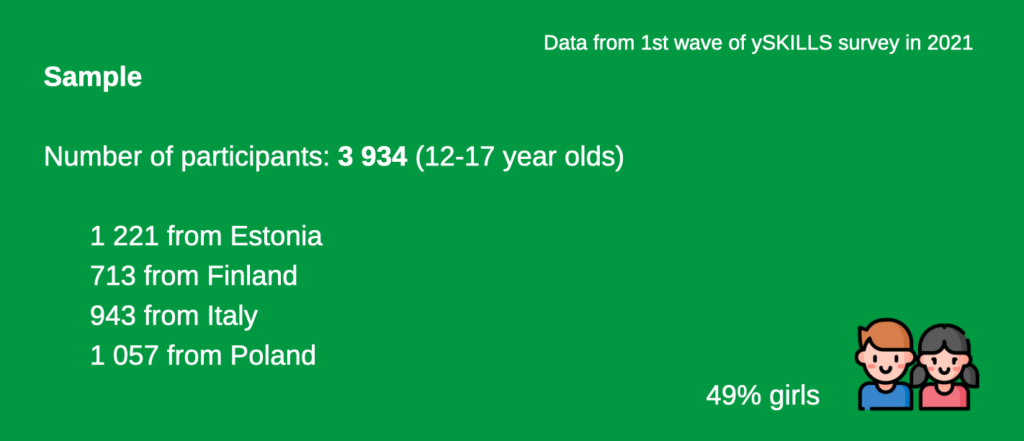
Figure 1: Cyberhate exposure, in % (N= 3 934)
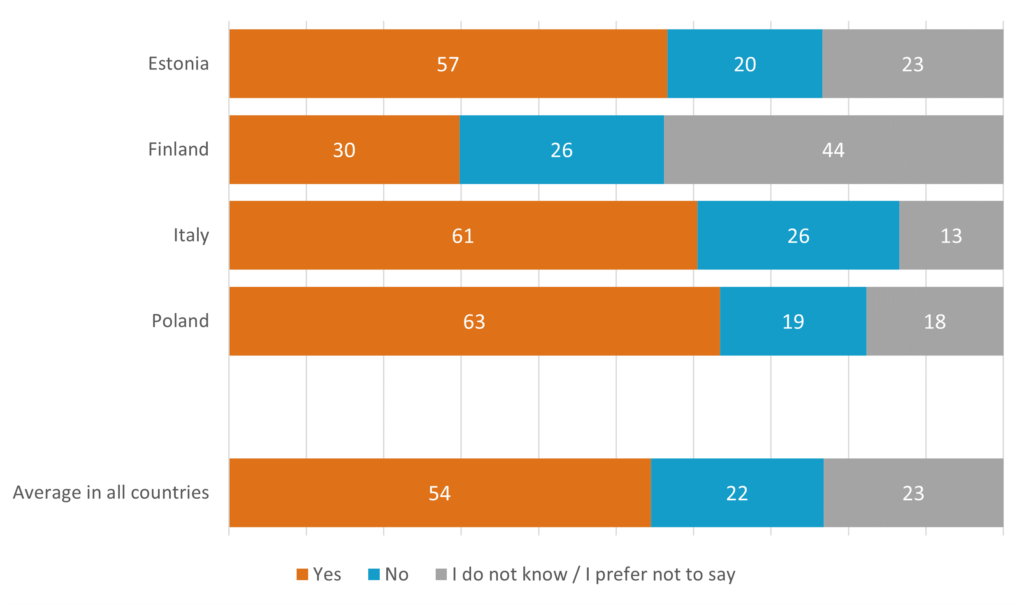
Note: Question: On the internet, you may encounter content that attacks certain groups or individuals (e.g., because of their skin colour, religion, nationality, gender, or sexuality). This could be, for example, Muslims, migrants, Jews, Roma, etc. This could be in the form of hateful, degrading, or racist messages, comments, images, or videos. In the past year, have you seen something like this online or on a phone? In the past year, have you seen something like this online or on the phone? Only valid percentages are reported.
Intentional and unintentional exposure
Adolescents can be exposed to cyberhate in various ways. While some may encounter cyberhate unintentionally and as a by-product of their online interactions, others may purposefully seek such contents. Intentional and active searching for cyberhate can be connected to specific motivations, presenting a different experience from unintentional encounters. Therefore, it is necessary to also distinguish between these two contexts in our exploration of the role of digital skills.
Most young people are unintentionally exposed to cyberhate. They encounter it during their normal activities online. This was also the case in our sample. We asked those children and young people who reported being exposed to cyberhate during the past year, how this happened to them: 55 % reported that it happened to them unintentionally at least once during the past year. Only 30 % stated they intentionally looked for such content at least once during the past year. In general, most young people were exposed to cyberhate only occasionally rather than frequently. The majority stated they were exposed (unintentionally or intentionally) only once or a few times during the past year. Only a minority of children and young people reported more frequent experience with cyberhate.
Figure 2: Unintentional cyberhate exposure, in % (N = 3 934)
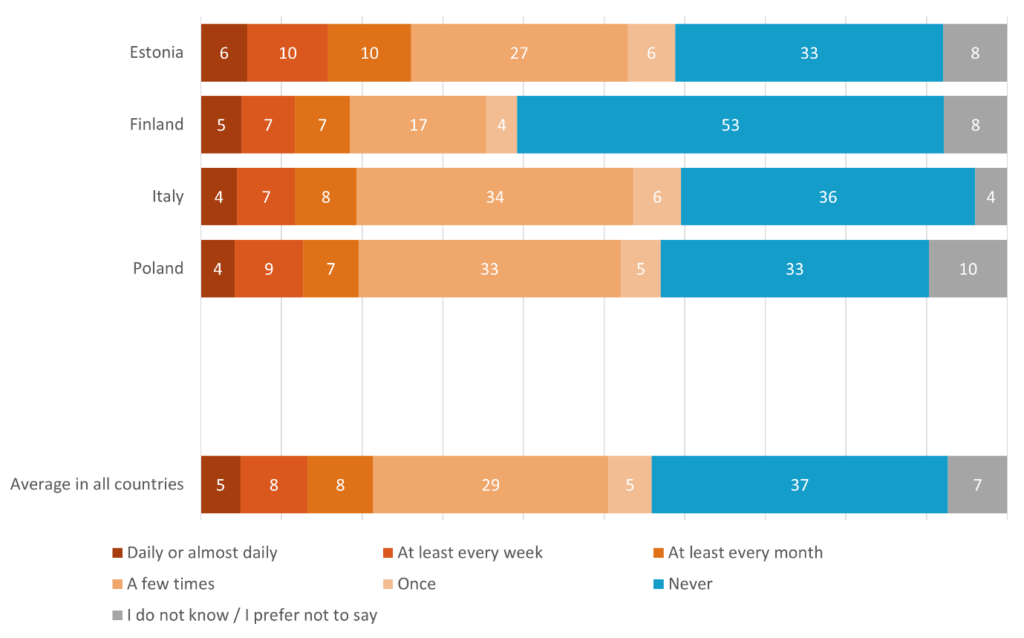
Note: Question: How often have you seen something like this when you did not intend to see it? Only valid % are reported. We also tested for correlation of unintentional cyberhate exposure with time spent online (About how long do you spend on the internet during a regular weekday? (i.e., school day)). There is a small to medium relationship, r = .204, p < .001.
Figure 3: Intentional cyberhate exposure, in % (N = 3 934)
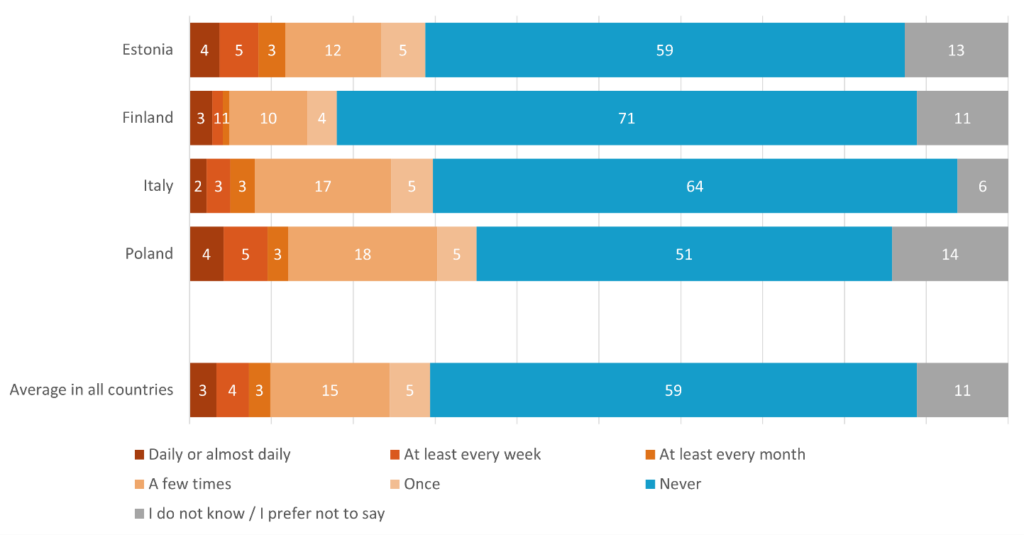
Note: Question: And how often have you seen something like this when you intended to see it? Only valid percentages are reported. We also calculated the correlation of intentional cyberhate exposure with time spent online (About how long do you spend on the internet during a regular weekday (i.e., school day)?). The relationship turned out to be small, r = .156, p < .001.
The role of digital skills
In the ySKILLS project, digital skills range from technical and operational skills to communication and interaction skills. We focused on the overall score of digital skills that encompasses all of these various dimensions.
Digital skills measurement in ySKILLS: We measured digital skills via a composite score of high skill levels for each dimension of skills, i.e. (1) technical and operational skills; (2) programming; (3) information navigation and processing skills; (4) communication and interaction skills; (5) content creation and production skills; and (6) knowledge skills.
More information about the measurements is available in this report.
Digital skills can help young people to take full advantage of the opportunities that the online space offers, whether it is entertaining or educational videos, part-time job offers, or access to a wealth of information from around the world. However, there are also many pitfalls and potentially harmful contents in such a diverse online space. One of these pitfalls includes exposure to cyberhate content. Mastering digital skills can help young people recognise hateful contents and avoid places or interactions where they are shared. However, digital skills are also connected to greater exploration of the digital world, interacting with more people, and visiting diverse online platforms, including those with harmful contents.
The acquisition of digital skills is to be seen as a double-edged sword that can be both helpful and harmful. It is also important to understand the differential role of digital skills in intentional and unintentional exposure to cyberhate.
Our hypothesis is as follows: When intentionally seeking cyberhate, digital skills may facilitate this activity, as children and young people would know how to search for the right platforms, how to use related keywords, or how to get access to online hateful discussions, for instance. Conversely, when unintentionally exposed to such content, digitally skilled children and young people could use their digital skills to block or mute users or set their privacy settings with the purpose of not seeing such materials. Therefore, we asked whether digital skills can serve as a risk or a protective factor when exposed to different types of cyberhate.
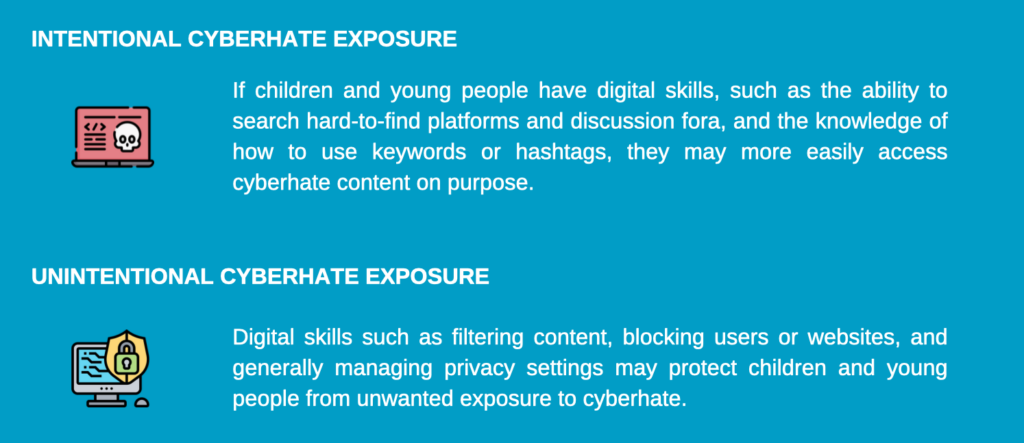
Key findings
Our study pointed at gender differences: digital skills are a risk factor for intentional exposure more in the case of boys than in the case of girls. Especially boys with higher digital skills are more likely to intentionally search for cyberhate content. In contrast, digital skills make no difference for intentional exposure in the case of girls. This means that higher skills offer more ways to find this content (e.g., via search engines, chatting with like-minded peers, or using hashtags). Hence, it would be fruitful to further explore this gender difference by inquiring about the places where and reasons why young people seek cyberhate contents, and which specific skills they use to do so.
It was further shown that high sensation seekers (i.e., more inclined to explore new experiences, seeking for adrenaline) are more likely to experience unintentional exposure to cyberhate when their digital skills are low. Higher digital skills, thus, may serve as a protective factor for such sensation seekers and their unintentional exposure. In other words, adolescents without the necessary skills may be less able to avoid cyberhate exposure while searching for sensational stuff online (e.g., filtering hateful content).
Our takeaways
The double-edged nature of digital skills
- The role of digital skills needs to be considered in relation to other factors and children’s personality characteristics.
- Digital skills interact differently with unintentional exposure to cyberhate than with intentional search for such content
- While digital skills can protect young sensation seekers from unwanted and potentially harmful exposure to content and enable them to more safely explore the online environment, they can also help children and young people interested in seeing hateful contents to find them more easily online. In our research, this was more true of boys.
- It is crucial for future research to distinguish between subtypes of digital skills to better understand which ones protect adolescents from unwanted experiences and to uncover which ones can increase the risk of intentionally seeking hateful contents, for whom, and in what situations.
- Furthermore, it is important to ask adolescents about their motivations for seeking cyberhate. There might be several reasons, ranging from excitement upon seeing such contents, a clear intention to share them, to learn more about them, or to engage in counterspeech.
- Understanding the double-edged nature of digital skills is crucial for educators and parents.
- In addition to teaching technical skills to young people, we also need to teach them to be critical of information, to understand how the online environment works, and how to cope with negative online experiences.





